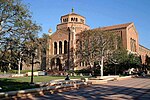The UCLA School of Education and Information Studies (Ed&IS) is one of the academic and professional schools at the University of California, Los Angeles. Located in Los Angeles, California, the school combines two distinguished departments whose research and doctoral training programs are committed to expanding the range of knowledge in education, information science, and associated disciplines. Established in 1881, the school is the oldest unit at UCLA, having been founded as a normal school prior to the establishment of the university. It was incorporated into the University of California in 1919. The school offers a wide variety of doctoral and master's degrees, including the M.A., M.Ed., M.L.I.S., Ed.D., and Ph.D., as well as professional certificates and credentials in education and information studies. It also hosts visiting scholars and a number of research centers, institutes, and programs. Ed&IS recently initiated an undergraduate major in Education & Social Transformation in addition to the minor that it has offered in Education Studies.Both of its departments have consistently ranked highly among graduate schools of education and Master's of Library and Information Science by U.S. News & World Report in every year in which the magazine has published such rankings. U.S. News & World Report does not rank doctoral programs in information studies, but the information studies faculty consistently ranks among the most productive and highly cited faculty in its field, according to a standard quadrennial peer-reviewed study by professors within that field. Ed&IS faculty are members of the American Academy of Arts and Sciences, Institute of Medicine, American Association for the Advancement of Science, and the National Academy of Education.Admission to Ed&IS is highly selective, particularly admission to the departments' doctoral programs; between 60 and 70% of those admitted enroll. Roughly 150 doctoral students in education and 8 doctoral students in information studies are admitted to the school each year. Each class in the two-year MLIS and MA programs in information studies has approximately 80 students, while each class in the one-year M.Ed. and MA programs in education has approximately 250 students. The name of the department was changed to UCLA School of Education and Information Studies (Ed&IS) in 2020 to reflect its expanding mission to serve undergraduates as well as graduate students.








